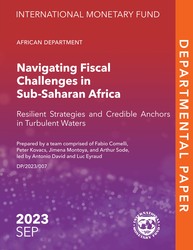
Navigating Fiscal Challenges in Sub-Saharan Africa: Resilient Strategies and Credible Anchors in Turbulent Waters
Significant reforms are needed in Sub-Saharan Africa to rebuild buffers and preserve the sustainability of public finances. A strategic approach to fiscal policy is needed, as policies in the region typically lack an effective anchor and are overly focused on short-term goals.
READ MORE...
Volume/Issue:
Volume 2023
Issue 007
Publication date: September 2023
ISBN: 9798400230349
$20.00
Add to Cart by clicking price of the language and format you'd like to purchase
Available Languages and Formats
| English |
Topics covered in this book
This title contains information about the following subjects.
Click on a subject if you would like to see other titles with the same subjects.
Economics- Macroeconomics , Public Finance , International - Economics , Public Policy , Fiscal Strategy , Fiscal Anchors , Political Economy , Africa , Covid-19 , fiscal policy-Sub-Saharan Africa , fundamentals in Sub-Saharan Africa , debt Tolerance fundamentals , risk status , factors impacting debt Tolerance , government debt burden in Sub-Saharan Africa , Fiscal consolidation , Fiscal stance , Sub-Saharan Africa , Global
Summary
Sub-Saharan African countries have been hit, in recent years, by a cascading series of shocks that have exacerbated fiscal vulnerabilities. Significant reforms are needed to rebuild buffers and preserve the sustainability of public finances. The paper argues that a strategic approach to fiscal policy is needed, as policies in the region typically lack an effective anchor and are excessively focused on short-term goals. An explicit debt target is a crucial element of the fiscal strategy. But calibrating this anchor is a difficult exercise. This paper contributes to the debate by proposing a novel method tailored to the low-income country context, which relies on the principle of the preservation of debt-servicing capacity. Results using this method point to a median debt anchor of 55 percent of GDP in the region. Moreover, the paper also shows that most (though not all) countries will need to consolidate over the medium term to achieve prudent debt targets. Adjustment needs are in the order of 2 to 3 percent of GDP over the next five years for the median country. This consolidation seems feasible given historical experience and domestic revenue mobilization should play a central role in the adjustment process. Nevertheless, there is significant heterogeneity across countries: about a quarter of sub-Saharan African economies still have some fiscal space and can use it to continue making vital investments in human and physical capital. Finally, the paper discusses critical institutional reforms that are tailored to developing countries’ needs and constraints, including in the areas of medium-term budgeting, fiscal risk management, expenditure controls and revenue administration.
Copyright © 2010 - 2025
Powered by:
AIDC



